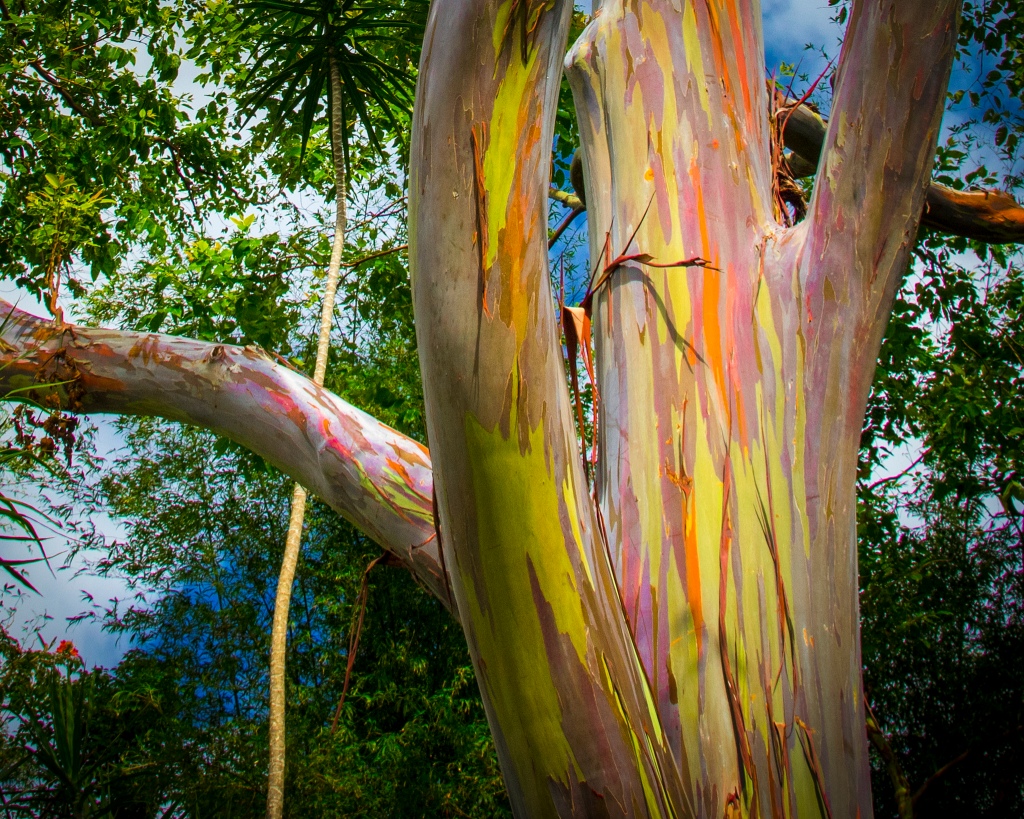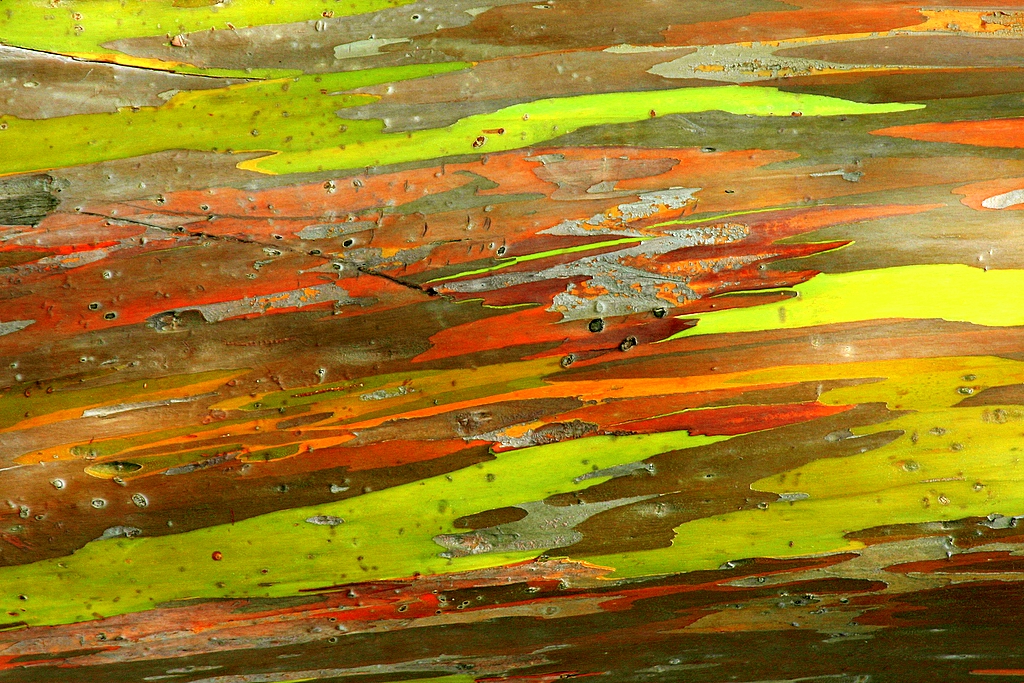When it comes to trees and their color, the discussion is usually focused on the beautiful yellows and browns of Fall leaves. But in the case of the eucalyptus deglupta, or rainbow eucalyptus, it’s the trunk that changes color. After the tree sheds its bark, it bursts into a technicolor display of oranges, blues, and greens.
The rainbow eucalyptus hails from Mindanao, an island in the southern part of the Philippines. It was initially called the Mindanao gum, and is known locally as bagras. Like many other eucalyptus trees, it grows quickly to heights exceeding 60 meters (200 feet).

Rainbow Eucalyptus trees on the road to Hana in Hawaii – photo credit Jim Mullhaupt
The tall evergreen trees are the only members of the eucalyptus genus that grow in the Northern Hemisphere. In their native Philippines, they are used extensively to make paper and paper products, but they have also been introduced in Hawaii and other places as a decorative tree.
Traditionally, they have many uses in folk medicine. The leaves are antiseptic, and were used for wounds and in teas to treat asthma and coughs. The leaves and tree are also said to have the particularly useful characteristic of repelling mosquitoes.

The Mindanao Gum or rainbow eucalyptus is native to the Philippines – photo credit Thomas
What causes the colorful rainbow eucalyptus?
According to research by David Lee, professor at Florida International University and author of the book Nature’s Palette: The Science of Plant Color, the change takes place on the microscopic level. When the bark is stripped away, bright green chlorophyll is readily visible through a thin transparent surface layer that’s just one cell thick.
As time passes, reddish brown tannins build up in the surface layer, changing the apparent color. The chlorophyll beneath also dies down with time, creating the incredible fluorescent display that the tree is known for. The tree prefers wet, humid climates, and although the color can be observed anywhere, the display is brightest in the trees that grow in their native Mindanao.

The colorful bark of the rainbow eucalyptus – photo credit carvalho
Lee thinks that the process is a way to prevent other organisms from growing on the tree’s trunk. This defense system helps the tree grow strong quickly, and the colors are a fortunate side effect for those of us with sight.
There are notable trees all over the Pacific islands, as well as Hawaii and botanical gardens around the world. However, they are treated as an invasive species in many places, so take care before planting them in your home garden.
If you enjoyed this article about the rainbow eucalyptus, check out the archive for more tree stories. Also check out the Facebook page, with a few extra tree goodies throughout the week. Subscribe below to receive notifications whenever a new tree story is published.
As always, feel free to drop a comment below. I’d love to hear about any rainbow eucalyptus trees you’ve found around the world!
Further reading:
https://www.sciencefriday.com/articles/rainbow-in-a-tree/
http://www.stuartxchange.org/EucalyptusDeglupta.html
Affiliate disclosure: This article contains affiliate links. This means I may receive a small commission on purchases, at no extra cost to you.

Such an amazing tree! 😀
LikeLiked by 2 people
I love trees! There’s so much to learn about and from them, and they are so beautiful! Thanks for sharing.
LikeLiked by 2 people
Never knew it existed! Thank you for telling us about it, really beautiful 🙂
LikeLiked by 2 people
It is hard to argue there might be a tree more beautiful than this one! Thank you for sharing.
LikeLiked by 1 person
Too many eucalypti do too well here and some become invasive exotics. However, we can not grow the rainbow gum. It does not like frost.
LikeLiked by 2 people
The only place I’ve heard about them growing in the continental US is Florida. I’m surprised they can’t survive in California though!
LikeLiked by 1 person
They might survive in the coastal part of San Diego County, and maybe even as far as Santa Barbara County. I never investigated their potential there because I was only interested in growing them here and in Los Angeles County a few miles in from the coast. I have tried things in Los Angeles County that have no business there, and some things did not work, but it was worth the try. I do not live there, so can not take care of the plants that we experiment with.
LikeLike
They do survived in California in Humboldt County. Im from Mindanao Philippines and I’m surprised when I saw this kind of tree here in California.
LikeLiked by 1 person
This is awesome! Very surreal but wonderful.
LikeLiked by 2 people
They certainly are unusual! Not sure where they can be seen in and around Europe, however…
LikeLiked by 1 person
Hello, greetings from Baguio, Benguet! We have them here but not as brightly rainbow colored as the ones in their natural habitat in Mindanao. The easiest to find is right in the city, along Harrison Road. Coming from the Melvin Jones football stage, walk straight ahead in the direction of Hotel Veniz, it is on the left side of the sidewalk where the flower stalls are.
LikeLiked by 1 person
Qué maravilla, no tenía ni idea de que existiera algo así!!
LikeLiked by 1 person
Pingback: PH Indigenous and Exotic Tree Species – TODAY'S PAPER
Wondering where they can be found in Mindanao. Are there any in or near the Caraga region?
LikeLike
Pingback: Here's Where You Can Find These 'Rainbow' Trees In The Philippines - When In Manila
Pingback: In Search of Mindanao (Rainbow) Gum Tree – Explore to Discover Life
Pingback: The Magic of the Earth – Beyond Routes